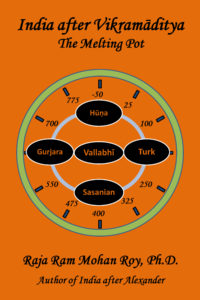
India after Vikramaditya: The Melting Pot
Author: Dr. Raja Ram Mohan Roy
In “India after Alexander: The Age of Vikramādityas”, a new chronology was constructed for the period spanning from the invasion of India by Alexander to the death of Emperor Vikramāditya in 57 BCE. In this book, the chronological reconstruction of Indian history is continued, beginning with the rise of the Sātavāhanas. The revised dating of the Kushāṇas is confirmed by the identification of the Kushāṇa king Vasudeva II with King Basdeo, whose daughter was married to the Sasanian king, Bahram V. The chronology of the Vallabhī kings is calculated by counting their dates from the Śaka Era instead of the Vallabhī Era. The new chronology validates the numerous Rajput genealogies describing the celebrated Bappa Rawal as a descendant of Śilāditya VII in the eighth generation. Current historians place Śilāditya VII chronologically after Bappa Rawal. The chronology of the Gurjara kings is fixed by counting their dates from the Śaka Era instead of the Kalachuri-Chedi Era. For the first time, the histories of Persia, Vallabhī, the Gurjaras, the Later Guptas, the Pushyabhūtis, the Maukharis, the Hūṇas and the Turks are critically analyzed to reconstruct the epic Battle of Korūr, which is currently deleted from the pages of history.

